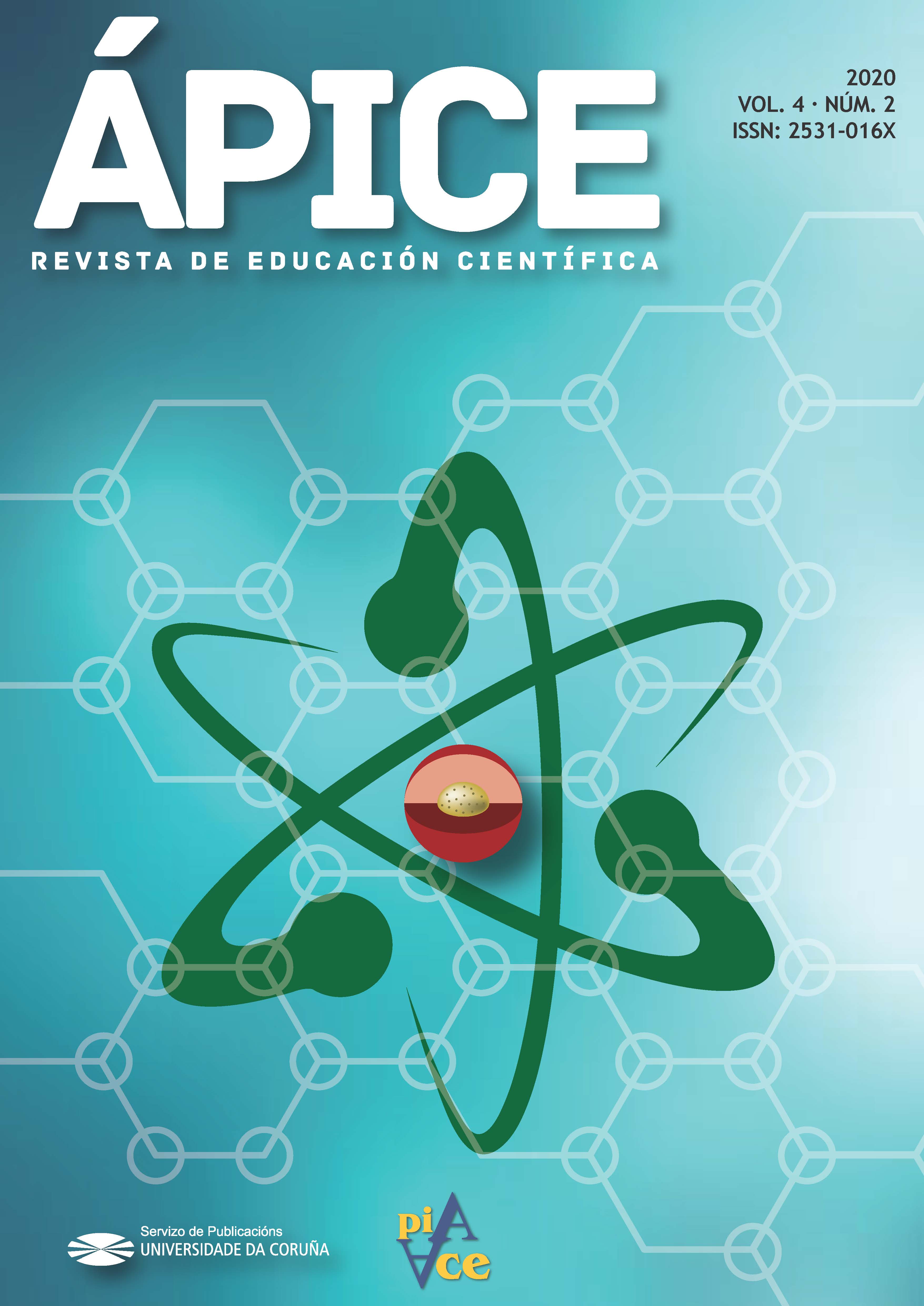Pre-service teacher-generated analogies for biology concepts: implications for teacher training
Main Article Content
Abstract
Analogies are an effective strategy for active learning. Nevertheless, research in science education shows that most teachers use analogies on an irregular or inconsistent basis, possibly owing to a lack of targeted training at the pre-service level. This article presents an exploratory study of this overlooked line of research, based on an analysis of the analogies proposed by 231 pre-service primary teachers for a selection of biology concepts taught at different stages of the primary school curriculum. The results showed that most of the participants were unable to formulate appropriate analogies, especially for more abstract concepts, such as cells, immune response or nerve impulse transmission. The study also observed a tendency to mix analogies with examples and practical experiences. The findings indicate that primary education students are insufficiently prepared by their teacher training to use analogies as a teaching and learning strategy for the biology curriculum.
Keywords:
Downloads
Article Details
References
Aubusson, P. J., Harrison, A. G. y Ritchie, S. M. (2005). Metaphor and analogy in science education. Dordrecht: Springer.
Baysen, E. y Baysen, F. (2013). Turkish prospective kindergarten teachers’ conceptions concerning some selected atmospheric events. International Journal of Elementary Education, 2(5), 32-37. DOI: https://doi.org/10.11648/j.ijeedu.20130205.11
Coll, R. (2015). Analogies in Science. En R. Gunstone (Ed.), Encyclopedia of Science Education (pp. 41-42). Dordrecht: Springer.
Davis, E. A. y Petish, D. (2005) Real-world applications and instructional representations among prospective elementary science teachers. Journal of Science Teacher Education, 16(4), 263-286. DOI: https://doi.org/10.1007/s10972-005-8892-4
Dagher, Z. R. (1995). Analysis of analogies used by science teachers. Journal of Research in Science Teaching, 32(3), 259-270.
Duit, R. (1991). On the role of analogies and metaphors in learning science. Science education, 75(6), 649-672.
Esteban, R., Marcos-Merino, J. M., y Ochoa de Alda, J. A. G. (2017). Introducción a la evolución molecular a través de una analogía lingüística. Enseñanza de las Ciencias, Extra, 3669-3676.
Glynn, S. M. (2008). Making science concepts meaningful to students: teaching with analogies. En S. Mikelskis-Seifert, U. Ringelband, M. Bruckmann (Eds.), Four Decades of Research in Science Education: from Curriculum Development to Quality Improvement (pp. 113-127). Munster: Waxmann
Jonane, L. (2015). Analogies in science education. Pedagogika, 119(3), 116–125.
Kim, M., Kim, H., y Noh, T. (2018). The characteristics of lessons using analogies planned by pre-service science teachers. Journal of the Korean Chemical Society, 62(2), 148-158. DOI: https://doi.org/10.5012/jkcs.2018.62.2.148
Körhasan, N. D., y Hidir, M. (2019). How should textbook analogies be used in teaching physics?. Physical Review Physics Education Research, 15(1), 010109. DOI: https://doi.org/10.1103/PhysRevPhysEducRes.15.010109
Kurt, S. (2019). An Analogy Activity for Teaching Chemical Reaction and Collision Theory from Perspectives of Pre-Service Science Teachers. International Journal of Environmental and Science Education, 14(9), 521-534.
Marcos-Merino, J. M. (2020). Emociones y aprendizaje en las actividades prácticas de Biología en Educación Primaria y en el Grado de Maestro en Educación Primaria (Tesis Doctoral). Universidad de Extremadura, Badajoz.
Mastrilli, T. M. (1997). Instructional analogies used by biology teachers: Implications for practice and teacher preparation. Journal of Science Teacher Education, 8(3), 187-204. DOI: https://doi.org/10.1023/A:1009451802467
Nottis, K. E. K. y McFarland, J. (2001). A comparative analysis of pre-service teacher analogies generated for process and structure concepts. Electronic Journal of Science Education, 5(4).
Oliva, J. M. (2008). Qué conocimientos profesionales deberíamos tener los profesores de ciencias sobre el uso de analogías. Revista Eureka sobre Enseñanza y Divulgación de las Ciencias, 5(1), 15-28. DOI: https://doi.org/10.25267/rev_eureka_ensen_divulg_cienc.2008.v5.i1.03
Oliva, J. M., Aragón, M. M., Bonat, M. y Mateo, J. (2001). Una propuesta didáctica basada en la investigación para el uso de analogías en la enseñanza de las ciencias. Enseñanza de las Ciencias, 19(3), 453-470.
Oliva, J. M., Aragón, L. y Jiménez, N. (2015). Analogías y progresión del conocimiento del alumnado en la clase de ciencias. Alambique: Didáctica de las ciencias experimentales, (79), 35-44.
Ordoñez, C., Cardona, J., Daza, A., Rodas, J. y Ruiz, F. (2013). Relaciones entre el uso de la analogía en la enseñanza y el aprendizaje del concepto Estructura Íntima de la Materia. Enseñanza de las Ciencias, Extra, 2616-2621.
Orgill, M. y Bodner, G. (2004). What research tells us about using analogies to teach chemistry. Chemistry Education Research and Practice, 5(1), 15-32. DOI: https://doi.org/10.1039/B3RP90028B
Real Decreto 126/2014, de 28 de febrero, por el que se establece el currículo básico de Educación Primaria.
Richland, L. E. y Simms, N. (2015). Analogy, higher order thinking, and education. Wiley Interdisciplinary Reviews: Cognitive Science, 6(2), 177-192. DOI: https://doi.org/10.1002/wcs.1336
Rubio, J., Sánchez, G. y Valcárcel, M.V. (2018). Percepción de profesores y estudiantes de 3ºESO sobre el uso de analogías en el estudio de los estados de agregación de la materia. Revista Eureka sobre Enseñanza y Divulgación de las Ciencias, 15(2), 2104. DOI: https://doi.org/10.25267/Rev_Eureka_ensen_divulg_cienc.2018.v15.i2.2104
Treagust, D., Duit, R., Joslin, P. y Lindauer, I. (1992). Science teachers’ use of analogies: observations from classroom practice. International Journal of Science Education, 14(4), 413-422. DOI: https://doi.org/10.1080/0950069920140404
Yerrick, R., Doster, E., Nugent, J., Parke, H. y Crawley, F. E. (2003). Social interaction and the use of analogy: An analysis of preservice teachers' talk during physics inquiry lessons. Journal of Research in Science Teaching, 40(5), 443-463. DOI: https://doi.org/10.1002/tea.10084



